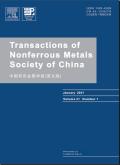Calcium titanate corrosion inhibitor enabling carbon as inert anode for oxygen evolution in molten chlorides
IF 4.7
1区 材料科学
Q1 METALLURGY & METALLURGICAL ENGINEERING
Transactions of Nonferrous Metals Society of China
Pub Date : 2024-10-01
DOI:10.1016/S1003-6326(24)66616-1
引用次数: 0
Abstract
The corrosion inhibition efficacy of titanate (CaTiO3) for carbon anodes in molten salts was investigated through various analytical techniques, including linear sweep voltammetry, X-ray diffraction, scanning electron microscopy, and energy dispersion spectroscopy. The results demonstrate that the addition of CaTiO3 corrosion inhibitor efficiently passivates the carbon anode and leads to the formation of a dense CaTiO3 layer during the electrolysis process in molten CaCl2−CaO. Subsequently, the passivated carbon anode effectively undergoes the oxygen evolution reaction, with an optimal current density for passivation identified at 400 mA/cm2. Comprehensive investigations, including CaTiO3 solubility tests in molten CaCl2−CaO and numerical modeling of the stability of complex ionic structures, provide compelling evidence supporting “complexation−precipitation” passivation mechanism. This mechanism involves the initial formation of a complex containing TiO2·nCaO by CaTiO3 and CaO, which subsequently decomposes to yield CaTiO3, firmly coating the surface of the carbon anode. In practical applications, the integration of CaTiO3 corrosion inhibitor with the carbon anode leads to the successful preparation of the FeCoNiCrMn high-entropy alloy without carbon contamination in the molten CaCl2−CaO.
钛酸钙缓蚀剂使碳成为熔融氯化物中氧进化的惰性阳极
通过线性扫描伏安法、X 射线衍射、扫描电子显微镜和能量色散光谱等多种分析技术,研究了钛酸盐(CaTiO3)在熔盐中对碳阳极的缓蚀效果。结果表明,在熔融 CaCl2-CaO 的电解过程中,添加 CaTiO3 缓蚀剂可有效钝化碳阳极,并形成致密的 CaTiO3 层。随后,钝化的碳阳极会有效地发生氧进化反应,钝化的最佳电流密度为 400 mA/cm2。包括 CaTiO3 在熔融 CaCl2-CaO 中的溶解度测试和复杂离子结构稳定性数值建模在内的综合研究提供了令人信服的证据,支持 "络合-沉淀 "钝化机制。该机制包括 CaTiO3 和 CaO 初步形成含有 TiO2-nCaO 的复合物,随后分解生成 CaTiO3,牢固地包覆在碳阳极表面。在实际应用中,将 CaTiO3 缓蚀剂与碳阳极结合在一起可成功制备出铁钴镍铬锰高熵合金,而不会在熔融 CaCl2-CaO 中产生碳污染。
本文章由计算机程序翻译,如有差异,请以英文原文为准。
求助全文
约1分钟内获得全文
求助全文
来源期刊
CiteScore
7.40
自引率
17.80%
发文量
8456
审稿时长
3.6 months
期刊介绍:
The Transactions of Nonferrous Metals Society of China (Trans. Nonferrous Met. Soc. China), founded in 1991 and sponsored by The Nonferrous Metals Society of China, is published monthly now and mainly contains reports of original research which reflect the new progresses in the field of nonferrous metals science and technology, including mineral processing, extraction metallurgy, metallic materials and heat treatments, metal working, physical metallurgy, powder metallurgy, with the emphasis on fundamental science. It is the unique preeminent publication in English for scientists, engineers, under/post-graduates on the field of nonferrous metals industry. This journal is covered by many famous abstract/index systems and databases such as SCI Expanded, Ei Compendex Plus, INSPEC, CA, METADEX, AJ and JICST.

 求助内容:
求助内容: 应助结果提醒方式:
应助结果提醒方式:


